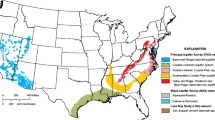Abstract
In the present study, during a period of 16 months Colilert 3000 was validated in laboratory and field tests and compared to standard laboratory methods for monitoring of coliforms and E. coli. No false positive/negative results for coliforms/E. coli were found in 80 potable well water samples monitored with the Colilert 3000 and compared to standard methods. Although usage of Colilert 3000 to monitor raw water is not recommended by the manufacturer, the E. coli results of 100 samples were 100% positive by membrane filtration, Colilert 18 and MPN and only 80% positive by the Colilert 3000. In addition, in all positive samples, Colilert 3000 and Colilert 18 showed higher results of two to three orders of magnitude compared to MF and MPN. This significant difference was probably due to the presence of Aeromonas spp. and Vibrio spp. (natural inhabitants of the raw surface water) known to interfere with the Colilert test. Treated surface water was monitored by Colilert 3000 for the presence of coliforms and E. coli. Among the 100 samples tested in parallel by membrane filtration all were negative, while with Colilert 3000 only 76% were negative. Post-test identification of the positive samples did not reveal the presence of E. coli but interfering microorganisms. The last application was to evaluate Colilert 3000 to monitor accidental or deliberate pollution of drinking water with sewage sources. Among 20 samples spiked with raw sewage (0.1 and 1%) all results were positive for both coliforms and E. coli. The time span required for Colilert 3000 to detect positive samples was 6–10 h compared to 24 h with the standard membrane filtration.





Similar content being viewed by others
References
APHA (1998). Standard methods for the examination of water and wastewater (20th ed.). Washington, D.C.: American Public Health Association.
Chao, K.-K., Chao, C.-C., & Chao, W.-L. (2004). Evaluation of colilert-18 for detection of coliforms and E. coli in subtropical freshwater. Applied and Environmental Microbiology, 70, 1242–1244.
Davies, C. M., Apte, S. C., Peterson, S. M., & Stauber, J. L. (1994). Plant and algal interference in bacterial β-D-galactosidase and β-D-glucoronidase assays. Applied and Environmental Microbiology, 60, 3959–3964.
Edberg, S. C., & Edberg, M. M. (1988). A defined substrate technology for the enumeration of microbial indicators in environmental pollution. Yale Journal of Biology and Medicine, 61, 389–399.
Pisciotta, J. M., Rath, D. F., Stanek, P. A., Flanery, D. M., & Harwood, V. J. (2002). Marine bacteria cause false-positive results in the Colilert-18 rapid identification test for Escherichia coli in Florida waters. Applied and Environmental Microbiology, 68, 539–544.
Shadix, L. C., & Rice, E. W. (1991). Evaluation of β-glucuronidase assay for the detection of Escherichia coli from environmental waters. Canadian Journal of Microbiology, 37, 908–911.
Tryland, I., & Fiksdal, L. (1998). Enzyme characteristics of β-D-galactosidase-and β-D-glucuronidase-positive bacteria and their interference in rapid methods for detection of waterborne coliforms and Escherichia coli. Applied and Environmental Microbiology, 64, 1018–1023.
Tryland, I., Samset, I. D., Hermansen, L., Berg, J. D., & Rydberg, H. (2001). Early warning of faecal contamination of water: A dual mode, automated system for high- (<1 hour) and low-levels (6–11 hours). Water Science and Technology, 43(12), 217–220.
Tryland, I., Surman, S., & Berg, J. D. (2002). Monitoring faecal contamination of the Thames estuary using a semiautomated early warning system. Water Science and Technology, 46(3), 25–31.
Acknowledgements
The authors wish to thank Mekorot Water Company for financial support and NBT Ltd., Israel for supplying the Colilert 3000 apparatus.
Author information
Authors and Affiliations
Corresponding author
Additional information
R. Armon is a member of the Grand Water Research Institute.
Rights and permissions
About this article
Cite this article
Zuckerman, U., Hart, I. & Armon, R. Field Evaluation of Colilert 3000 for Ground, Raw and Treated Surface Water and Comparison with Standard Membrane Filtration Method. Water Air Soil Pollut 188, 3–8 (2008). https://doi.org/10.1007/s11270-007-9421-1
Received:
Revised:
Accepted:
Published:
Issue Date:
DOI: https://doi.org/10.1007/s11270-007-9421-1




